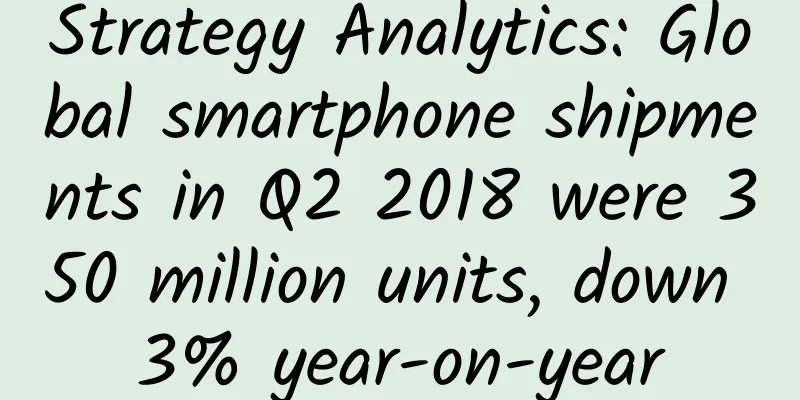Strategy Analytics: Global smartphone shipments in Q2 2018 were 350 million units, down 3% year-on-year

|
Strategy Analytics ' latest research report points out that global smartphone shipments fell 3 % year-on-year to 350 million units in Q2 2018. Samsung maintained its first place with a 20 % global smartphone market share, while Huawei surpassed Apple for the first time in history to become the world's second largest smartphone manufacturer. “Global smartphone shipments fell 3% year-on-year from 360.4 million units in Q2 2017 to 350.4 million units in Q2 2018,” said Qian Sui, Director at Strategy Analytics. “The global smartphone market has slowed down this year due to longer replacement cycles, reduced operator subsidies, and a lack of new hardware design innovations.” Neil Mawston, Executive Director at Strategy Analytics, added, “Samsung’s global smartphone shipments fell 10% year-on-year from 79.5 million in Q2 2017 to 71.5 million in Q2 2018. This was Samsung’s worst quarterly performance since Q3 2016. Samsung is being squeezed out by Chinese rivals such as Xiaomi and Huawei in key Asian markets such as China and India. Huawei’s global smartphone shipments surged 41% year-on-year from 38.4 million in Q2 2017 to a record 54.2 million in Q2 2018. For the first time ever, Huawei surpassed Apple to become the world’s second largest smartphone vendor. Huawei accounted for 15% of the global smartphone market share during the quarter. Huawei’s mid-range Android models, such as the Nova 2S and Nova 3e, are popular in Asian and European markets.” Woody Oh, director of Strategy Analytics, added, “In Q2 2018, Apple iPhone shipped 41.3 million smartphones worldwide, with a market share of 12%, an above-average year-on-year growth of 1%. Apple continues to grow in smartphones, but at a much slower pace than Chinese competitors such as Huawei and Xiaomi. If Apple hopes to increase shipments in the future, the iPhone needs new innovative designs - perhaps by adding new features such as dual SIM or a foldable screen.” Qian Sui, Director at Strategy Analytics, added, “Xiaomi shipped 32 million smartphones worldwide in Q2 2018 and ranked fourth with a record global market share of 9% – up three percentage points from 6% year-on-year. Xiaomi’s shipments grew 38% year-on-year, but this is down from 58% a year ago. Xiaomi’s growth is currently slowing due to fierce competition from Huawei in key markets such as India and China. OPPO accounted for 9% of the global smartphone market share in Q2 2018, ranking fifth, slightly higher than 8% a year ago. OPPO has been hit hard by Xiaomi’s rapid expansion over the past year, but OPPO has finally stabilized and fought back with stronger pricing, while also strengthening new models such as the R15 with dual SIM cards. Figure 1: Global smartphone vendor shipments and market share in Q2 2018 |
<<: SME: 2019 Social Media Marketing Industry Report
Recommend
What to do if you get "hot" after eating oranges, eating melon seeds, and drinking beverages during the Chinese New Year? 4 ways to relieve it
During the holidays at home, I can’t stop eating ...
What is the best sleeping position to protect your spine?
Have you ever paid attention to your sleeping pos...
Why does the guppy's tail rot? What should I do if the guppy's tail rots?
As people's quality of life improves, more an...
What should I do if there is a small fleshy lump next to my nipple?
Women’s nipples are very fragile and need special...
The best Chinese medicine for breast hyperplasia
Breast hyperplasia is a symptom that threatens th...
Precautions and diet after curettage
The main purpose of this surgical method is to av...
Who touched your breasts?
Breasts are a woman's second appearance besid...
Is Taihu white shrimp considered seafood? When will Taihu white shrimp be available?
Taihu white shrimps have thin shells, tender meat...
Introduction to the Health and Beauty Sutra for Women
A smart woman should learn to pamper herself. Her...
What to do if you have accessory breasts during pregnancy
If accessory breasts appear during pregnancy, you...
Hip pain in 4 months of pregnancy
Female friends who are about to become pregnant m...
The zoo has issued a "fruit ban", how should we eat fruit? | Ficus microcarpa
Eating fruit in the zoo can cause diabetes . Is f...
What does caesarean section wound fat liquefaction mean? What should I do if caesarean section wound fat liquefaction occurs?
We all know that cesarean section is a common way...
I got my period suddenly after getting angry.
Menstruation can be said to be one of the indicat...
What fruits can I eat during miscarriage? It turns out that these 5
The recovery period after a woman’s miscarriage i...









